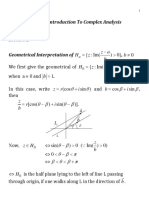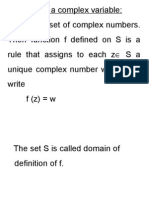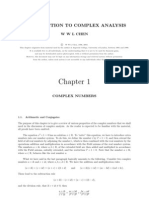0 ratings0% found this document useful (0 votes)
24 viewsComplex Functions
Uploaded by
rambabuaageyaCopyright
© © All Rights Reserved
Available Formats
Download as PDF or read online on Scribd
0 ratings0% found this document useful (0 votes)
24 viewsComplex Functions
Uploaded by
rambabuaageyaCopyright
© © All Rights Reserved
Available Formats
Download as PDF or read online on Scribd
You are on page 1/ 41
You might also like
- Complex Functions: 1 Sets. NeighborhoodsNo ratings yetComplex Functions: 1 Sets. Neighborhoods4 pages
- Topic_6_Complex_variable_analysis_with_applicationsNo ratings yetTopic_6_Complex_variable_analysis_with_applications36 pages
- UNIT-III-T. Veerarajan Complex Differentiation100% (1)UNIT-III-T. Veerarajan Complex Differentiation100 pages
- 18.112: Functions of A Complex Variable: Lecturer: Professor Wei Zhang Notes By: Andrew Lin Fall 2019No ratings yet18.112: Functions of A Complex Variable: Lecturer: Professor Wei Zhang Notes By: Andrew Lin Fall 20195 pages
- 2 Complex Functions and The Cauchy-Riemann EquationsNo ratings yet2 Complex Functions and The Cauchy-Riemann Equations11 pages
- Z A H Z B Z H Z B B: Introduction To Complex AnalysisNo ratings yetZ A H Z B Z H Z B B: Introduction To Complex Analysis14 pages
- (Halburd) Review of Complex Analysis PDFNo ratings yet(Halburd) Review of Complex Analysis PDF15 pages
- 3. Limit Continuty, Diffrentiabiliy of complex functionNo ratings yet3. Limit Continuty, Diffrentiabiliy of complex function20 pages
- Mathematics Magazine Mathematics Magazine: Analytic Functions Analytic FunctionsNo ratings yetMathematics Magazine Mathematics Magazine: Analytic Functions Analytic Functions14 pages
- Complex Variable and Analytic Function Harmonic FunctionsNo ratings yetComplex Variable and Analytic Function Harmonic Functions8 pages
- CA2 - Complex Functions - Annotated 241030 Final (1)No ratings yetCA2 - Complex Functions - Annotated 241030 Final (1)68 pages
- Introduction To Complex Analysis (Lecture Notes, 2003) ChenNo ratings yetIntroduction To Complex Analysis (Lecture Notes, 2003) Chen194 pages
- Introduction To Complex Analysis Lecture Notes - W. ChenNo ratings yetIntroduction To Complex Analysis Lecture Notes - W. Chen194 pages
- Complex Analysis A Short Course: M.Thamban Nair Department of Mathematics Indian Institute of Technology MadrasNo ratings yetComplex Analysis A Short Course: M.Thamban Nair Department of Mathematics Indian Institute of Technology Madras113 pages
- Topic_6_Complex_variable_analysis_with_applicationsTopic_6_Complex_variable_analysis_with_applications
- 18.112: Functions of A Complex Variable: Lecturer: Professor Wei Zhang Notes By: Andrew Lin Fall 201918.112: Functions of A Complex Variable: Lecturer: Professor Wei Zhang Notes By: Andrew Lin Fall 2019
- 2 Complex Functions and The Cauchy-Riemann Equations2 Complex Functions and The Cauchy-Riemann Equations
- Z A H Z B Z H Z B B: Introduction To Complex AnalysisZ A H Z B Z H Z B B: Introduction To Complex Analysis
- 3. Limit Continuty, Diffrentiabiliy of complex function3. Limit Continuty, Diffrentiabiliy of complex function
- Mathematics Magazine Mathematics Magazine: Analytic Functions Analytic FunctionsMathematics Magazine Mathematics Magazine: Analytic Functions Analytic Functions
- Complex Variable and Analytic Function Harmonic FunctionsComplex Variable and Analytic Function Harmonic Functions
- CA2 - Complex Functions - Annotated 241030 Final (1)CA2 - Complex Functions - Annotated 241030 Final (1)
- Introduction To Complex Analysis (Lecture Notes, 2003) ChenIntroduction To Complex Analysis (Lecture Notes, 2003) Chen
- Introduction To Complex Analysis Lecture Notes - W. ChenIntroduction To Complex Analysis Lecture Notes - W. Chen
- Complex Analysis A Short Course: M.Thamban Nair Department of Mathematics Indian Institute of Technology MadrasComplex Analysis A Short Course: M.Thamban Nair Department of Mathematics Indian Institute of Technology Madras





















































